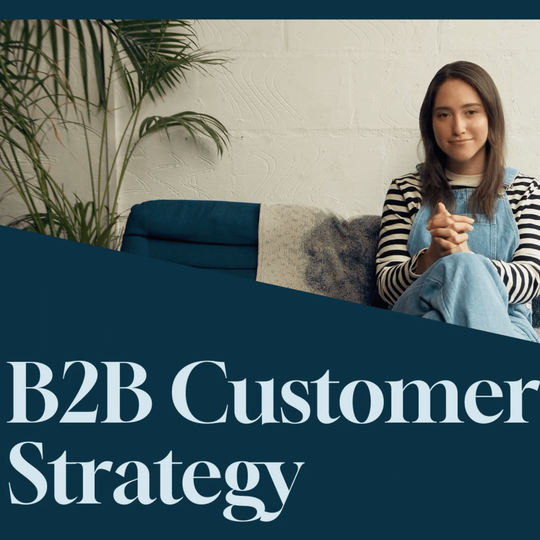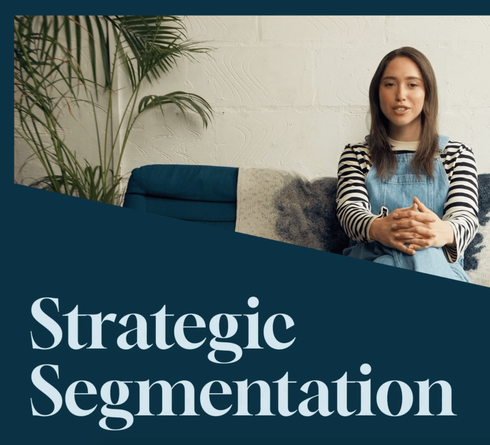
A B2B customer strategy is like a compass for your organization. It helps you make decisions, interact with clients, and create value for both your business and your clients. This strategy brings together your team, processes, insights, and systems all focused on putting the customer first.
Peter Lavers, a well-known expert in customer experience and co-founder of Customer Attuned, believes that successful B2B relationships require structured approaches that deliver measurable results. His knowledge in relationship marketing has led to proven methods that change how businesses connect with their B2B customers.
This guide will show you the important steps to create a B2B customer strategy that leads to long-term growth. You'll learn about:
- A tested framework with 12 building blocks for developing a customer strategy
- Practical tools for understanding different types of customers and mapping their journey
- Ways to get your teams working together towards goals that prioritize the customer
- Methods for assessing and enhancing your relationships with customers
- Plans for setting up effective feedback systems
Whether you're starting from scratch or improving what you already have, this guide offers practical tips to strengthen your B2B customer relationships and achieve business success.
1. Understanding the Foundations: The Building Blocks of a Successful B2B Customer Strategy
A strong B2B customer strategy is built on four key elements that serve as its foundation:
1. Purpose, Vision & Rules of Engagement
Your organization's purpose defines why you exist beyond profit generation. A clear vision statement articulates where you want to go, while rules of engagement establish how you'll interact with customers. These elements create a unified direction that resonates across all departments and team members.
2. Customer Culture
A customer-centric culture puts your clients at the heart of decision-making processes. This means:
- Empowering employees to prioritize customer needs
- Celebrating customer success stories
- Incorporating customer feedback into product development
- Creating reward systems tied to customer satisfaction
3. Customer Value Objectives
Your strategy needs specific, measurable objectives that define value creation for both your organization and your customers:
- Revenue growth targets
- Customer retention rates
- Market share goals
- Customer lifetime value metrics
- Joint innovation initiatives
These building blocks work together to create a framework that guides your entire organization. When properly implemented, they transform abstract customer-centricity concepts into tangible business practices that drive mutual growth and success.
Your customer value objectives serve as concrete markers for progress, helping teams understand their role in delivering value. They bridge the gap between high-level strategic vision and day-to-day operational decisions, ensuring every action aligns with your customer-focused mission.
2. Developing a Business Case and Setting KPIs for Customer Initiatives
Building a compelling business case for B2B customer strategy initiatives requires a data-driven approach focused on tangible outcomes. Your business case should highlight:
- Revenue Impact
- Increased customer retention rates
- Higher share of wallet
- New business opportunities through referrals
- Cost Reduction
- Lower customer acquisition costs
- Reduced service delivery expenses
- Minimized customer churn
Measuring success demands a balanced mix of Key Performance Indicators (KPIs):
Core Customer Experience Metrics
- Net Promoter Score (NPS): Measures customer advocacy
- Customer Satisfaction (CSat): Tracks satisfaction across touchpoints
- Customer Effort Score (CES): Evaluates interaction ease
Trust and Loyalty Metrics
- Retention rates by segment
- Contract renewal velocity
- Share of wallet percentage
- Referral rates
Your KPIs should directly link to business objectives. Example alignment:
Business Goal: 20% revenue growth ↓ Customer Value Objective: Increase share of wallet ↓ KPI: Average revenue per account
Track these metrics through:
- Monthly performance dashboards
- Quarterly business reviews
- Annual strategic assessments
Customize measurement frequency based on your business cycle and customer interaction patterns. Regular monitoring enables quick identification of trends and necessary strategy adjustments.
3. Using Analytics and Segmentation for Insight-Led Strategy
Data analytics transforms raw customer information into actionable insights for your B2B strategy. By analyzing purchase patterns, engagement metrics, and interaction data, you'll uncover valuable trends that shape customer behavior in B2B markets.
Key Analytics Areas to Focus On:
- Purchase frequency and volume
- Contract renewal rates
- Product usage patterns
- Customer service interactions
- Digital engagement metrics
The Customer Segmentation Canvas helps you organize these insights into meaningful customer segments. This strategic tool breaks down your B2B customers based on:
- Business Value MetricsRevenue contribution
- Profitability
- Growth potential
- Strategic importance
- Behavioral CharacteristicsDecision-making processes
- Communication preferences
- Technology adoption rates
- Service level requirements
Your segmentation strategy should identify 3-5 distinct customer groups with unique needs and behaviors. Each segment requires specific:
- Value propositions
- Service levels
- Communication approaches
- Resource allocation
By applying analytics to these segments, you'll spot opportunities for customized solutions, targeted marketing campaigns, and improved service delivery. This data-driven approach enables precise resource allocation and helps prioritize customer initiatives based on potential ROI.
The insights gained through analytics and segmentation directly inform your customer journey mapping and experience design strategies.
4. Mapping the Customer Lifecycle and Designing Experience Journeys
Customer lifecycle management in B2B contexts tracks the complete journey of business relationships - from initial awareness through partnership maturity. This systematic approach helps you understand and optimize each stage of customer interaction with your brand.
Key Lifecycle Stages in B2B:
- Awareness & Discovery: First touchpoints and research phase
- Evaluation & Selection: Detailed assessment of solutions
- Purchase & Implementation: Contract signing and onboarding
- Usage & Support: Regular product/service utilization
- Growth & Expansion: Account development opportunities
- Advocacy & Reference: Customer becomes brand ambassador
Creating detailed journey maps reveals critical touchpoints at each stage. These visual representations highlight:
- Customer Actions: What businesses do at each stage
- Pain Points: Common challenges and friction areas
- Moments of Truth: Key decision points that impact relationship success
- Emotional States: Business stakeholders' sentiments throughout
- Internal Processes: Required backend operations and support
Your journey maps should capture both digital and human interactions, considering multiple stakeholders within client organizations. This comprehensive view enables you to:
- Identify gaps in current service delivery
- Prioritize improvement initiatives
- Design proactive engagement strategies
- Align internal resources with customer needs
Using an experience design blueprint helps standardize journey mapping across different customer segments while maintaining flexibility for unique relationship dynamics.
5. Enabling Omni-channel Engagement for Seamless Interactions
B2B customers expect seamless interactions across multiple touchpoints. An effective omni-channel strategy connects these interactions into a unified experience, regardless of the platform or channel used.
Key Components of B2B Omni-channel Engagement:
- Digital Platforms Integration: Customer portals, mobile applications, e-commerce solutions, social media presence
- Traditional Channels: Face-to-face meetings, phone support, email communications, print materials
Your B2B customers switch between channels based on convenience, time constraints, and specific needs. A sales representative might initiate contact through a phone call, follow up via email, share product specifications through a customer portal, and close the deal in person.
Creating Channel Consistency:
- Maintain uniform branding across all platforms
- Sync customer data between channels in real-time
- Enable seamless transitions between different touchpoints
- Provide consistent pricing and product information
- Train staff to deliver standardized service quality
The strength of omni-channel engagement lies in its ability to capture customer interactions across every touchpoint. This comprehensive view helps you understand customer preferences, track engagement patterns, and personalize future interactions based on historical data.
A robust omni-channel strategy empowers your B2B customers to engage with your business on their terms while maintaining the professional relationship they expect.
6. Defining Propositions and Contact Plans Tailored to Customers' Needs
Creating value-driven propositions in B2B requires deep understanding of your customer segments' specific pain points and business objectives. You'll need to craft targeted solutions that directly address these challenges while delivering measurable value.
Key Elements of Effective B2B Propositions:
- Clear articulation of business benefits
- Quantifiable ROI metrics
- Specific solutions for industry challenges
- Competitive differentiation points
- Customization options for segment needs
Your contact strategy must align with your customers' preferences and business rhythms. A well-designed contact plan considers:
Contact Planning Framework:
- Preferred communication channels
- Decision-maker availability patterns
- Industry-specific timing considerations
- Account relationship stage
- Purchase cycle alignment
Proactive engagement requires balancing touchpoint frequency with meaningful interactions. You can achieve this through:
Strategic Touchpoint Planning:
- Regular business reviews
- Product update notifications
- Market insight sharing
- Performance reporting sessions
- Strategic planning meetings
The most successful B2B relationships maintain consistent, valuable interactions without overwhelming customers. Your contact strategy should adapt based on customer feedback and engagement metrics, ensuring each interaction adds value to the relationship.
7. Building Capabilities for Effective CX Delivery
Successful B2B customer strategy execution demands robust capabilities across your organization. A systematic approach to capability enhancement ensures your team can deliver exceptional customer experiences consistently.
Critical Skills Assessment
Assess the following skills within your organization:
- Customer relationship management expertise
- Data analysis and interpretation abilities
- Digital technology proficiency
- Cross-functional collaboration skills
- Problem-solving and decision-making capabilities
Resource Requirements
Identify the resources needed for effective CX delivery:
- Dedicated CX teams
- Technology infrastructure
- Training and development programs
- Performance monitoring tools
- Knowledge management systems
Your capability enhancement strategy should focus on three key areas:
- Training Programs
- Technology Adoption
- Process Improvements
1. Training Programs
Implement training programs that address the following areas:
- Role-specific skill development
- Cross-functional knowledge sharing
- Leadership development for CX champions
- Regular refresher courses
2. Technology Adoption
Adopt technology solutions that support your CX efforts:
- CRM system implementation
- Analytics tools integration
- Automation of routine tasks
- Digital collaboration platforms
3. Process Improvements
Improve your existing processes to enhance CX delivery:
- Standardized operating procedures
- Quality control mechanisms
- Performance metrics tracking
- Feedback incorporation systems
A structured capability assessment helps identify gaps in your current setup. Map these gaps against your strategic objectives to prioritize enhancement initiatives. Regular skill audits ensure your team maintains the necessary competencies to deliver superior customer experiences.
Create dedicated learning paths for different roles within your organization. This targeted approach ensures each team member develops the specific capabilities needed for their contribution to the customer strategy.
8. Integrating Data & Technology to Support Strategy Execution
A strong technological infrastructure is essential for successfully implementing a B2B customer strategy. By using the right combination of data and technology solutions, businesses can effectively manage customer relationships and make informed decisions.
CRM System Selection
When choosing a CRM system, consider the following factors:
- Prioritize systems that align with your specific industry requirements
- Look for scalability features to accommodate business growth
- Ensure integration capabilities with existing tech stack
- Select platforms offering comprehensive analytics and reporting tools
- Consider mobile accessibility for field sales teams
Creating Unified Customer Views
To create a comprehensive view of your customers, implement the following strategies:
- Implement data warehousing solutions to centralize customer information
- Use API connections to sync data across multiple platforms
- Deploy customer data platforms (CDPs) for real-time data integration
- Establish data governance protocols to maintain information accuracy
- Enable cross-departmental access to customer insights
Key Integration Considerations
When integrating different systems, keep these considerations in mind:
- Map data flows between systems to identify potential gaps
- Set up automated data validation checks
- Create standardized data formats across platforms
- Build secure data transfer protocols
- Implement regular system health monitoring
Your data integration strategy should focus on creating a single source of truth for customer information. Modern CRM platforms like Salesforce, HubSpot, or Microsoft Dynamics offer robust integration capabilities that can connect with various business systems - from marketing automation to ERP solutions.
9. Using Voice of the Customer (VoC) Feedback Loops
Voice of the Customer (VoC) programs are direct channels to understand your B2B customers' needs, expectations, and pain points. A well-structured VoC program captures feedback through multiple touchpoints:
- Regular Surveys: Implement quarterly business reviews and annual relationship assessments to gauge satisfaction levels and identify improvement areas
- In-depth Interviews: Schedule one-on-one sessions with key stakeholders to uncover deeper insights about their business challenges and requirements
- Digital Feedback Tools: Deploy real-time feedback mechanisms after service interactions, product usage, or support encounters
Creating actionable insights from VoC data requires:
- Systematic Analysis: Use text analytics and sentiment analysis to identify patterns and trends in customer feedback
- Priority Matrix: Map feedback against business impact and effort required to address issues
- Closed-Loop Process: Establish protocols to act on feedback and communicate changes back to customers
Your VoC program should integrate with:
- Account management processes
- Product development cycles
- Service delivery improvements
- Strategic planning initiatives
By embedding VoC feedback loops into your B2B customer strategy, you create a continuous improvement cycle that strengthens customer relationships and drives business growth.
10. Assessing Current State Using Intention-Reality-Effect Framework
The Intention-Reality-Effect assessment methodology, developed by Customer Attuned, provides a structured approach to evaluate your B2B customer strategy implementation. This framework examines three critical dimensions:
1. Intention
- Your strategic goals and planned customer initiatives
- Documented processes and procedures
- Stated commitments to customers
- Resource allocation plans
2. Reality
- Actual execution of customer initiatives
- Day-to-day operational practices
- Current resource utilization
- Employee behaviors and actions
3. Effect
- Impact on customer satisfaction and loyalty
- Business performance metrics
- Return on customer investments
- Market position and competitive advantage
The assessment process involves :
- Gap Analysis: Identifying discrepancies between intended strategies and actual implementation
- Root Cause Investigation: Understanding factors contributing to any misalignment
- Impact Assessment: Measuring the business effects of these gaps
- Priority Setting: Determining which areas require immediate attention
This systematic evaluation helps you pinpoint specific areas where your customer strategy needs strengthening. The framework's structured approach enables you to make data-driven decisions about resource allocation and improvement initiatives.
The assessment typically takes 12 weeks to complete, involving stakeholder interviews, process reviews, and performance data analysis. You'll receive a detailed report highlighting strengths, weaknesses, and recommended actions for improvement.
11. Aligning Internal Teams Around a Unified Customer-Centric Vision
Creating alignment across departments requires deliberate communication strategies that resonate with different teams. Here's how you can build a shared understanding of your customer-centric purpose:
Cross-Functional Workshops
- Organize interactive sessions where teams collaborate on customer journey mapping
- Create shared definitions of success metrics
- Develop collective understanding of customer pain points
Visual Communication Tools
- Design infographics displaying customer strategy roadmaps
- Create dashboards showing real-time customer feedback
- Share customer success stories through internal video content
Departmental Integration
- Establish regular cross-team meetings focused on customer experience
- Rotate staff between departments to build empathy
- Create shared objectives tied to customer outcomes
Leadership Engagement
- Leaders demonstrate customer-first behaviors
- Regular town halls featuring customer impact stories
- Recognition programs celebrating customer-centric achievements
Knowledge Sharing Platforms
- Implement internal communication channels dedicated to customer insights
- Create accessible repositories of customer feedback and success stories
- Develop training materials emphasizing customer-centric approaches
A unified customer vision emerges when teams understand their specific role in delivering value. Encourage departments to identify their unique contributions to the customer experience while maintaining alignment with the broader organizational strategy.
12. Measuring Success & Continuously Improving Your B2B Customer Strategy
Tracking performance metrics helps you refine and enhance your B2B customer strategy. Here's how to establish an effective measurement system:
Key Performance Indicators Dashboard
- Create a centralized dashboard displaying real-time KPI data
- Set up automated alerts for metrics falling below target thresholds
- Include trend analysis to spot patterns and anticipate changes
Regular Performance Reviews
- Schedule monthly cross-functional team meetings to analyze KPI data
- Document insights and action items from each review session
- Adjust targets based on market conditions and business objectives
Success Measurement Best Practices
- Break down complex metrics into actionable components
- Compare performance across different customer segments
- Track both leading and lagging indicators
- Measure customer lifetime value alongside short-term metrics
Continuous Improvement Actions
- Implement A/B testing for new customer initiatives
- Gather feedback from front-line teams about KPI relevance
- Update measurement criteria as business needs evolve
- Document successful interventions and replicate across segments
Your measurement system should adapt to changing business conditions while maintaining consistency in core metrics. Regular calibration of your KPIs ensures they remain aligned with your evolving B2B customer strategy and market dynamics.
Sign up for Customer Service
The best customer service newsletter !
No spam. Unsubscribe anytime.
Conclusion
Building a B2B customer strategy requires a systematic, well-planned approach backed by organizational commitment. Start with a thorough assessment of your current state using the Intention-Reality-Effect framework to identify gaps and opportunities.
Your implementation journey should follow these proven steps:
- Conduct an initial assessment
- Define clear objectives and KPIs
- Build internal capabilities
- Deploy technology solutions
- Establish feedback mechanisms
Success depends on:
- Leadership buy-in at every level
- Cross-departmental collaboration
- Consistent measurement and adaptation
- Long-term commitment to customer-centricity
Remember: A robust B2B customer strategy isn't a one-time project—it's an ongoing journey of improvement and adaptation. Your strategy should evolve as your customers' needs change and new opportunities emerge. Take the first step today by assessing your current customer strategy maturity and identifying areas where you can create greater value for your B2B relationships.
FAQs (Frequently Asked Questions)
What is a B2B customer strategy and why is it important for business success ?
A B2B customer strategy is a comprehensive approach that focuses on understanding and meeting the needs of business customers to drive long-term relationships and business growth. It is important because it aligns organizational efforts around customer-centric goals, enhances customer satisfaction, loyalty, and ultimately contributes to sustained business success.
Who is Peter Lavers and what role does he play in B2B customer strategy ?
Peter Lavers is a key influencer in customer experience (CX) and relationship marketing. He supports the adoption of customer-centric approaches in B2B markets, emphasizing the importance of building strategies that prioritize customer outcomes and engagement for improved business performance.
What are the fundamental building blocks of a successful B2B customer strategy ?
The fundamental building blocks include defining a clear purpose, vision, and rules of engagement; cultivating a strong customer culture focused on outcomes; and setting specific customer value objectives. These elements create organizational alignment and guide strategic decision-making to deliver meaningful value to customers.
How can businesses measure the success of their B2B customer initiatives ?
Success can be measured by establishing relevant Key Performance Indicators (KPIs) such as Net Promoter Score (NPS), Customer Satisfaction (CSat), Customer Effort Score (CES), as well as trust and loyalty metrics. Aligning these KPIs with business goals ensures effective tracking of progress and impact on customer value objectives.
What role does analytics and segmentation play in developing a B2B customer strategy ?
Analytics and segmentation provide deep insights into customer behaviors, preferences, and needs. Using tools like the Customer Segmentation Canvas enables businesses to identify meaningful segments for targeted strategies, ensuring that marketing efforts and propositions resonate effectively with different customer groups.
How can organizations integrate data and technology to support B2B customer strategy execution ?
Organizations can select appropriate Customer Relationship Management (CRM) systems to manage relationships and data efficiently. Leveraging data integration techniques helps create unified views of customers across platforms, enabling seamless omni-channel engagement and informed decision-making aligned with the overall strategy.
Related posts
DOSE OF WISDOM IN YOUR INBOX
By signing up for the Customer Service mailing list you will receive exclusive marketing resources, be the first to hear about events, workshops, and have access to subscriber only content!
Written by






